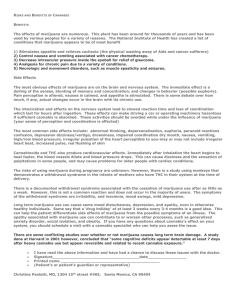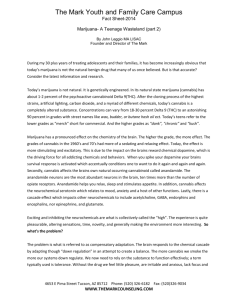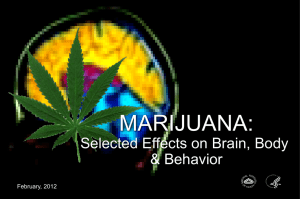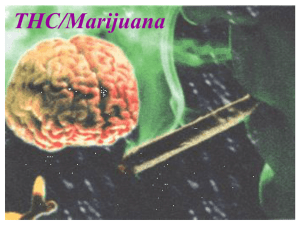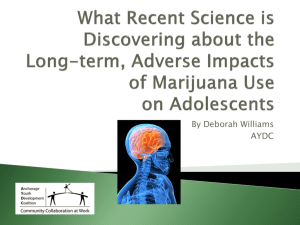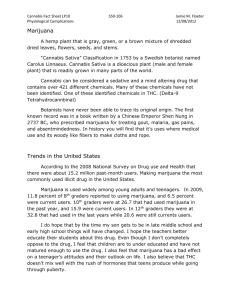MPI Literature Review- 2013 Wu et al. 2011. “Lasting Impacts of
advertisement
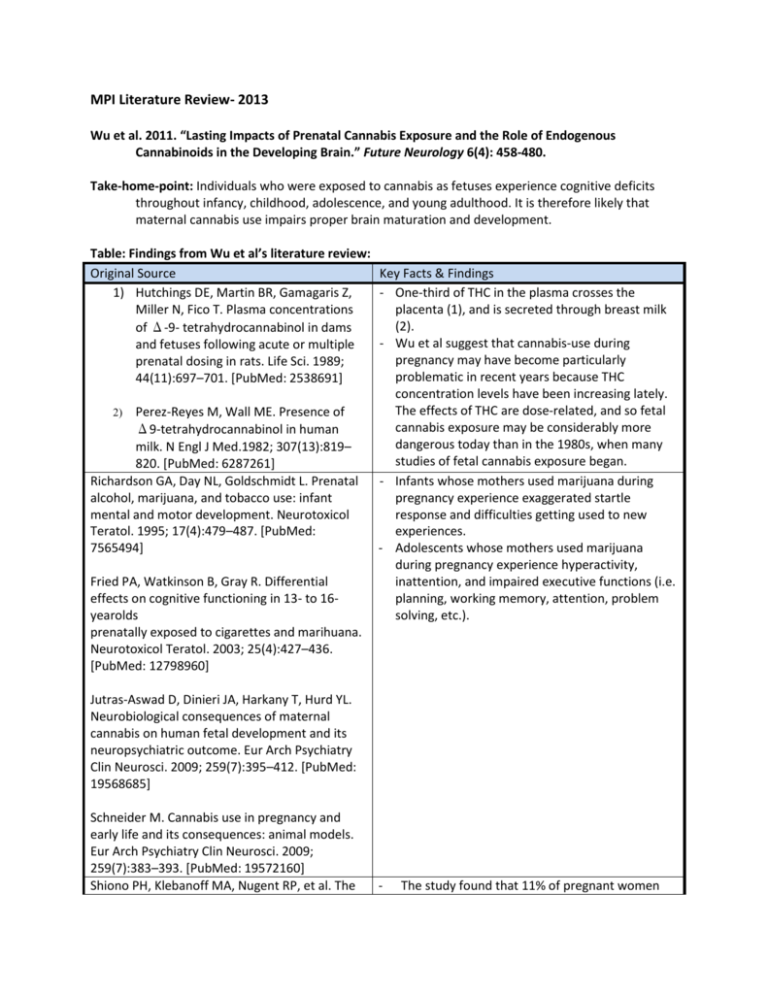
MPI Literature Review- 2013 Wu et al. 2011. “Lasting Impacts of Prenatal Cannabis Exposure and the Role of Endogenous Cannabinoids in the Developing Brain.” Future Neurology 6(4): 458-480. Take-home-point: Individuals who were exposed to cannabis as fetuses experience cognitive deficits throughout infancy, childhood, adolescence, and young adulthood. It is therefore likely that maternal cannabis use impairs proper brain maturation and development. Table: Findings from Wu et al’s literature review: Original Source Key Facts & Findings 1) Hutchings DE, Martin BR, Gamagaris Z, - One-third of THC in the plasma crosses the Miller N, Fico T. Plasma concentrations placenta (1), and is secreted through breast milk (2). of Δ-9- tetrahydrocannabinol in dams - Wu et al suggest that cannabis-use during and fetuses following acute or multiple pregnancy may have become particularly prenatal dosing in rats. Life Sci. 1989; problematic in recent years because THC 44(11):697–701. [PubMed: 2538691] concentration levels have been increasing lately. The effects of THC are dose-related, and so fetal 2) Perez-Reyes M, Wall ME. Presence of cannabis exposure may be considerably more Δ9-tetrahydrocannabinol in human dangerous today than in the 1980s, when many milk. N Engl J Med.1982; 307(13):819– studies of fetal cannabis exposure began. 820. [PubMed: 6287261] Richardson GA, Day NL, Goldschmidt L. Prenatal - Infants whose mothers used marijuana during alcohol, marijuana, and tobacco use: infant pregnancy experience exaggerated startle mental and motor development. Neurotoxicol response and difficulties getting used to new Teratol. 1995; 17(4):479–487. [PubMed: experiences. 7565494] - Adolescents whose mothers used marijuana during pregnancy experience hyperactivity, Fried PA, Watkinson B, Gray R. Differential inattention, and impaired executive functions (i.e. effects on cognitive functioning in 13- to 16planning, working memory, attention, problem yearolds solving, etc.). prenatally exposed to cigarettes and marihuana. Neurotoxicol Teratol. 2003; 25(4):427–436. [PubMed: 12798960] Jutras-Aswad D, Dinieri JA, Harkany T, Hurd YL. Neurobiological consequences of maternal cannabis on human fetal development and its neuropsychiatric outcome. Eur Arch Psychiatry Clin Neurosci. 2009; 259(7):395–412. [PubMed: 19568685] Schneider M. Cannabis use in pregnancy and early life and its consequences: animal models. Eur Arch Psychiatry Clin Neurosci. 2009; 259(7):383–393. [PubMed: 19572160] Shiono PH, Klebanoff MA, Nugent RP, et al. The - The study found that 11% of pregnant women impact of cocaine and marijuana use on low birth weight and preterm birth: a multicenter study. Am J Obstet Gynecol. 1995; 172(1 Pt 1):19– 27. [PubMed: 7847533] Wu et al describe research that covers a considerable time period. As a result, there are many references. I can provide a long list if it would be helpful. El Marroun H, Tiemeier H, Steegers EA, et al. Intrauterine Cannabis Exposure Affects Fetal Growth Trajectories: The Generation R Study. J Am Acad Child Adolesc Psychiatry. 2009 - - were using marijuana. Wu et al suggest that marijuana usage rates in pregnant women may not be considerably different than those among non-pregnant women. Wu et al describe two longitudinal studies of fetal marijuana exposure. In one, a Canadian study (OPPS), the original participants were primarily pregnant white women of high socioeconomic status. In another (MHPCD), the original participants were primarily pregnant African American and white women of low socioeconomic status living in Pittsburg, PA: - Finding from the Canadian study: In the neonatal stage (1-28 days old), fetal marijuana exposure was highly correlated with an increase in exaggerated startles, tremors, and difficulties getting used to light. - Finding from both studies: For 3-4 year olds, fetal marijuana exposure negatively impacted verbal reasoning and short term- memory development. - Findings from both studies: When children reached school age (ages 5-6), they experienced higher levels of impulsive and hyperactive behaviors. - Findings from both studies: Problems of depression, hyperactivity, inattention, and impulsivity persist until children reach 9-12 years old. - Findings from the Canadian study: Adolescents (ages 13-16) who were heavily exposed to marijuana as fetuses (more than .86 joints per day), demonstrated shortcomings in visual memory and analysis, and experienced problems maintaining attention. - Maternal cannabis use during pregnancy was associated with growth restriction in mid/ late pregnancy and lower birth weight.
